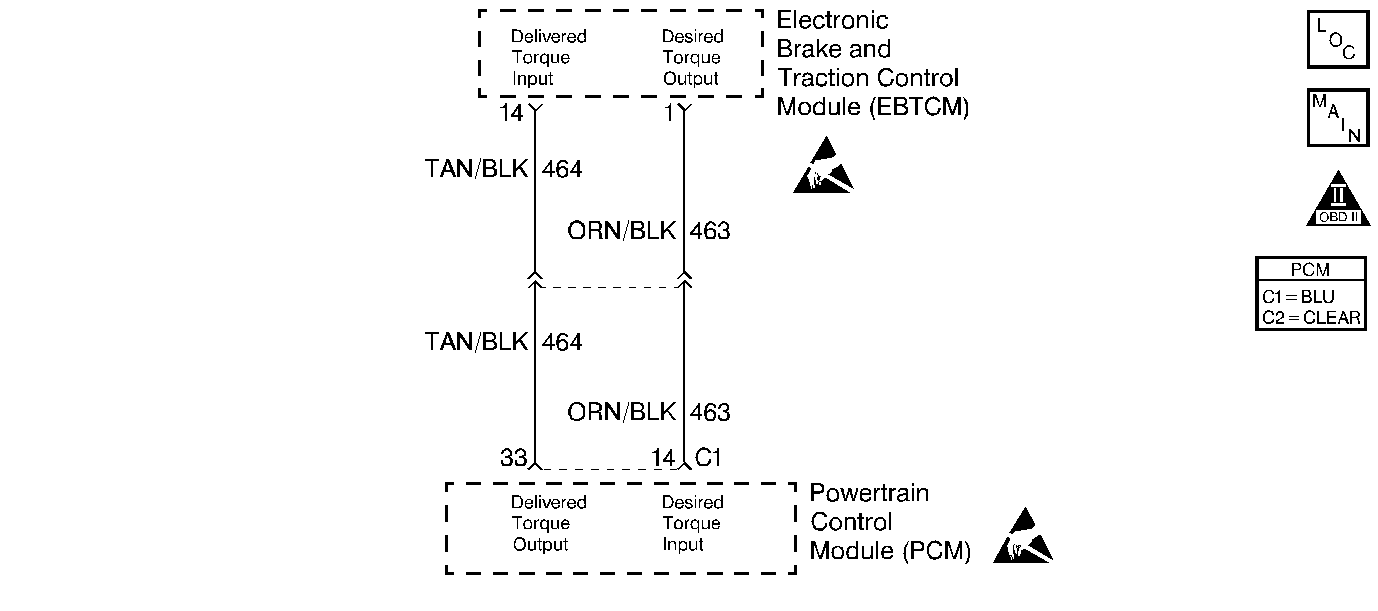
Circuit Description
The traction control system uses the antilock brake system in conjunction with the PCM fuel and ignition controls to limit drive wheel slippage during acceleration. The PCM controlled portion of the traction control system reduces engine torque by any or all of the following methods:
| • | Retarding spark timing. |
| • | Altering air/fuel ratio. |
| • | Altering boost PWM (VIN 1). |
| • | Shutting OFF up to three injectors. |
To determine the amount of torque reduction required, the PCM monitors the TCS Desired Torque PWM signal from the Electronic Brake and Traction Control Module (EBTCM). The PCM also provides a TCS Delivered Torque PWM informing the Electronic Brake and Traction Control Module (EBTCM) how much torque is being produced by the engine. The Desired Torque display on the scan tool indicates the amount of engine torque requested by the EBTCM. With traction control not active, Desired Torque should vary between 99% and 100%. The Desired Torque display on the scan tool is not the PWM duty cycle.
Conditions for Setting the DTC
Desired torque signal PWM duty cycle is less than 5 percent or greater than 95 percent.
Action Taken When the DTC Sets
| • | The PCM will not illuminate the malfunction indicator lamp (MIL). |
| • | The PCM will store conditions which were present when the DTC set as Failure Records data only. This information will not be stored as Freeze Frame data. |
Conditions for Clearing the MIL/DTC
| • | A History DTC will clear after 40 consecutive warm-up cycles have occurred without a malfunction. |
| • | The DTC can be cleared by using the scan tool Clear Info function. |
Diagnostic Aids
An intermittent may be caused by a poor connection, rubbed through wire insulation or a wire broken inside the insulation. Check for the following conditions:
| • | Poor Connection or Damaged Harness. |
| Inspect PCM harness for an open or short to ground in the desired torque PWM circuit, improper mating, broken locks, improperly formed or damaged terminals, poor terminal to wire connection, and damaged harness. |
| • | Intermittent Test |
| Using a scan tool, observe Desired Torque display while moving related connectors and wiring harness. If the failure is induced, the displayed value will change. This may help to isolate the location of the malfunction. |
Reviewing the Fail Records vehicle mileage since the diagnostic test last failed may help determine how often the condition that caused the DTC to be set occurs. This may assist in diagnosing the condition.
Step | Action | Value(s) | Yes | No |
|---|---|---|---|---|
1 | Was the Powertrain On-Board Diagnostic (OBD) System Check performed? | -- | ||
2 |
Is (Traction Control) Desired Torque at or near the specified value? | 100% | ||
3 |
Does voltage measure the specified value? | 5V | ||
4 |
Is frequency between the specified values? | 120 Hz-135 Hz | ||
5 |
Is duty cycle between the specified values? | 5-95% | ||
6 |
Was a problem found? | -- | ||
7 |
Was a problem found? | -- | ||
8 | Replace the EBTCM. Refer to On-Vehicle Service in ABS/TCS . Is action complete? | -- | -- | |
9 | Check for a poor connection at the PCM. If a problem is found, repair as necessary. Refer to Repair Procedures in Electrical Diagnosis. Was a problem found? | -- | ||
10 | Replace the PCM. Important:: The replacement PCM must be programmed. Refer to Powertrain Control Module Replacement/Programming . Is action complete? | -- | -- | |
11 |
Is (Traction Control) Desired Torque at or near the specified value? | 100% | System OK |
